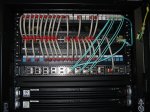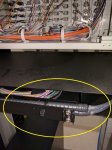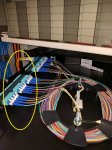By the way if it isn't clear to you, none of what I say here about your rack is anything other than constructive criticism and discussion of ideas and concepts. It usually takes a certain kind of person with either a lot of discipline or OCD-ish tendencies to get to the point you have.
No purpose but sitting there as storage. Only purpose is actually serving is to to support 5548 in case I need to replace it. So if I remove the front screws of 5548 it won't fall back cause it will have the 5448 underneath.
Switches suck that way. Glad to know I'm not the only one it annoys.
Space in 39 is not practical for use anyways. Then I came up with the genius idea how to utilize the spot 39 with device that is usefully and same time don't need access to it's front - RPS720. Brilliant, right ?
I'll give it a "not bad." It's an efficient use of space, granted, but it violates my rule that equipment should be removable without having to de-cable other things. In this case: your switch and the cables from the bottom patch panel.
That's how I felt about it. And after a year of struggling to fine a original rack mounting gear for it, I bought another Fujitsu (brand new) that came with everything , and now put the old one for sale. This tell you if I care about neatness or not.
So that is take care of now - Fujitsu is sitting on his own rails , not on top the old Dell server.(which was there only for that purpose.
Um, okay. Would it maybe have been cheaper to get some generic 1U brackets and just drill them as needed?
http://www.ebay.com/itm/L-Brackets-...Compatible-with-Dell-HP-SA-3301-/161139639793
http://www.ebay.com/itm/Penn-Elcom-R1206-1U-Rack-Mount-Bracket-1U-/321724242100
etc
Or is it actually on some sort of rail set?
For the dell 5548 and patch panels: I looked 1000's of rack pictures and I've given it a great deal of consideration how to do it, but as you point out if both panel are underneath the switch there will hard to remove individual cables and will add additional strain between cables. So I decide to go with the configuration 2 patch panes with switch in the middle to be the one make most sense for me.
P.S. If I was able to find(or make) a super-short patch cables , I would make same configuration without a gap between switch and patch panel , so I don't waste a that 1U space.
You can make patch cables yourself if you want. It isn't as cheap as the prebuilts, but you can make them to quarter-inch lengths easily.
Get a box of quality Cat6 stranded cable. This is absolutely NOT the same stuff you use when wiring Keystone jacks, etc., which is solid core wire. Must be stranded. Try to find 550MHz stranded.
Get yourself a
Platinum Tools EZ-RJ45 100054C crimper, a
15015 stripper, a
Triplett cable shear, and a
Klein VDV Scout Pro or something else to test basic connectivity/opens/shorts.
Then you need some strain reliefs
such as the EZ-RJ45 100030GY, and some
EZ-RJ45 crimps 100010C in the color of your choice.
There are a bunch of tutorials on the Internet about how to use the EZ-RJ45 stuff, most of them are fine, but the one thing is that I've rarely seen is a method to straighten the conductors that doesn't kill your fingers after about two connectors. My little contribution to the world is to use the rounded side edge on the 15015 to run the wires over several times and straighten them that way.

The downside to this is that it's suuuuuuuper-expensive to do the initial tool-up especially if you have any doubts as to whether or not you're going to be any good at making cables. If that's the case with you, contact me and maybe we can work something out.
The fiber is where I think I need help with.
Originally I was thinking to use only the last 5 of top patch panel for fiber connections. (my patch panels are with keystones so I can easily put fiber, RJ45 ,coax , or anything that you can put on keystone jack.)
Now besides the fact that 5 might not be enough, the question is what is the optimal way to organize it ?
I don't want make everything from scratch, and in the same time I would appreciate any change you could suggest ?
Well, I imagine the problem here is that you've got a home setup, so my natural inclination to separate fiber and copper and a bunch of other similar inclinations isn't appropriate to the discussion here. Am I right in guessing that this is all in the front side of your server rack? In some ways that makes this a little more difficult.
Can I fly off on a tangent here for a moment? One other thing I noticed was that you seem to maybe be doing this more for looks rather than for management/maintainability. In particular, I notice that you left switchports 21-24 empty, I'm guessing in a bid to "re-verticalize" your patches starting at #25-26. Most of us who professionally OCD over network wiring wouldn't do this because what we're actually optimizing for is manageability and maintainability, and the "looks nice" aspect comes in as a secondary benefit. Am I reading that correctly? There's absolutely no wrong answer to that question and I won't think less of you either way, but understanding the motivations behind what you've done so far may matter in trying to work out something intelligent and useful to say.
For discussion:
So the goal here is to avoid crossing gear with cables. To do that, cable management stuff like the Panduit enclosed wire management module at the top is kinda nice. When you don't have a lot of density you can even do things like bury slack inside it. The Siemon D ring units are better for higher density.
But your problem is that if you've got a door on that rack, then you don't really have a lot of room for wire management doodads. Plus, with servers below, I'm assuming you're doing some sort of front-to-rear jiggery to get your cabling from your switches to your servers? Switches rarely do all that well in the front of a rack, especially doored. Hm. I'll probably think of some more things to say.






